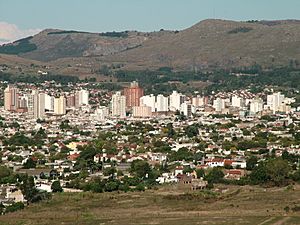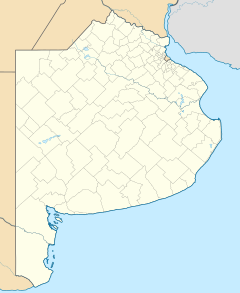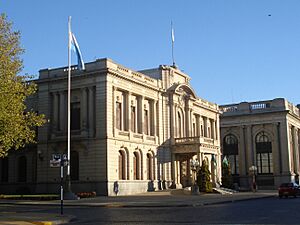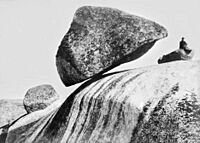Tandil facts for kids
Quick facts for kids
Tandil
|
|
|---|---|

Panoramic view of the city
|
|
| Country | Argentina |
| Province | Buenos Aires |
| Partido | Tandil |
| Founded | April 4, 1823 |
| Area | |
| • Total | 52.34 km2 (20.21 sq mi) |
| Elevation | 188 m (617 ft) |
| Population
(2010 census)
|
|
| • Total | 116,916 |
| • Density | 2,233.78/km2 (5,785.5/sq mi) |
| CPA Base |
B 7000
|
| Area code(s) | +54 249 |
Tandil is a major city in Argentina. It is located in the southeast of Buenos Aires Province. The city is nestled just north of the Tandilia hills. Tandil was founded on April 4, 1823. Its name comes from the famous Piedra Movediza (Moving Stone). This city is known for being the home of many famous sports stars. It is also the birthplace of a former president of Argentina, Mauricio Macri.
Contents
Discovering Tandil's Location and Size
Tandil sits about 180 meters (590 feet) above sea level. Its exact location is 37°19′08″S 59°08′05″W / 37.31889°S 59.13472°W. The city shares borders with several other towns. These include Rauch and Azul to the north. To the east, it borders Ayacucho and Balcarce. South of Tandil are Lobería, Necochea, and Benito Juárez. Finally, to the west, it borders Azul and Benito Juárez again.
Tandil is roughly in the middle of two important cities. It is about 330 kilometers (205 miles) northeast of La Plata, the provincial capital. It is also the same distance southwest of Bahía Blanca. Tandil is 160 kilometers (99 miles) northwest of Mar del Plata. It is also 360 kilometers (224 miles) south-southwest of Buenos Aires. The city is part of a region called the Humid Pampas. This area is known for its fertile land.
In 2010, a census showed that Tandil had a population of 116,916 people. The total area of the Tandil region, called a 'partido', is 4,935 square kilometers (1,905 square miles).
Tandil's Weather and Climate
Tandil has a mild and humid climate. It is known as an oceanic climate. The average temperature is 13.5°C (56.3°F). The city receives about 912.6 millimeters (35.9 inches) of rain each year. Mornings can be quite chilly in autumn, winter, and spring. Even in summer, they are often fresh.
Fog is very common during autumn and winter. Frosts also happen often in these seasons. Temperatures can drop below -5°C (23°F) in winter. Rain falls throughout the year, but it is more frequent in the summer months. Snow is not very common in Tandil.
The weather information below is based on data from 1991 to 2020:
| Climate data for Tandil, Argentina (1991–2020, extremes 1961–present) | |||||||||||||
|---|---|---|---|---|---|---|---|---|---|---|---|---|---|
| Month | Jan | Feb | Mar | Apr | May | Jun | Jul | Aug | Sep | Oct | Nov | Dec | Year |
| Record high °C (°F) | 40.7 (105.3) |
37.8 (100.0) |
37.2 (99.0) |
32.5 (90.5) |
28.0 (82.4) |
23.3 (73.9) |
25.4 (77.7) |
31.2 (88.2) |
30.0 (86.0) |
33.6 (92.5) |
35.4 (95.7) |
39.9 (103.8) |
40.7 (105.3) |
| Mean daily maximum °C (°F) | 28.4 (83.1) |
26.9 (80.4) |
24.5 (76.1) |
20.5 (68.9) |
16.5 (61.7) |
13.3 (55.9) |
12.5 (54.5) |
15.0 (59.0) |
16.9 (62.4) |
19.9 (67.8) |
23.4 (74.1) |
27.0 (80.6) |
20.4 (68.7) |
| Daily mean °C (°F) | 20.8 (69.4) |
19.6 (67.3) |
17.4 (63.3) |
13.5 (56.3) |
10.2 (50.4) |
7.2 (45.0) |
6.2 (43.2) |
8.2 (46.8) |
10.2 (50.4) |
13.3 (55.9) |
16.4 (61.5) |
19.5 (67.1) |
13.5 (56.3) |
| Mean daily minimum °C (°F) | 13.3 (55.9) |
12.7 (54.9) |
11.0 (51.8) |
7.4 (45.3) |
4.8 (40.6) |
2.0 (35.6) |
1.1 (34.0) |
2.4 (36.3) |
3.9 (39.0) |
6.8 (44.2) |
9.3 (48.7) |
11.6 (52.9) |
7.2 (45.0) |
| Record low °C (°F) | 1.8 (35.2) |
0.8 (33.4) |
0.0 (32.0) |
−4.6 (23.7) |
−5.8 (21.6) |
−11.0 (12.2) |
−11.6 (11.1) |
−8.5 (16.7) |
−7.1 (19.2) |
−4.8 (23.4) |
−4.0 (24.8) |
−0.3 (31.5) |
−11.6 (11.1) |
| Average precipitation mm (inches) | 108.8 (4.28) |
98.5 (3.88) |
91.6 (3.61) |
93.5 (3.68) |
56.0 (2.20) |
48.6 (1.91) |
41.1 (1.62) |
57.5 (2.26) |
58.7 (2.31) |
85.9 (3.38) |
98.4 (3.87) |
74.0 (2.91) |
912.6 (35.93) |
| Average precipitation days (≥ 0.1 mm) | 7.9 | 7.1 | 7.6 | 7.3 | 6.0 | 5.4 | 6.3 | 5.4 | 6.9 | 8.7 | 8.8 | 7.2 | 84.6 |
| Average snowy days | 0.0 | 0.0 | 0.0 | 0.0 | 0.1 | 0.1 | 0.1 | 0.1 | 0.0 | 0.0 | 0.0 | 0.0 | 0.2 |
| Average relative humidity (%) | 67.0 | 72.8 | 76.9 | 78.3 | 81.6 | 80.5 | 80.2 | 75.9 | 74.4 | 73.8 | 69.7 | 64.6 | 74.6 |
| Mean monthly sunshine hours | 254.2 | 240.1 | 220.1 | 186.0 | 142.6 | 114.0 | 127.1 | 164.3 | 159.0 | 213.9 | 231.0 | 232.5 | 2,284.8 |
| Mean daily sunshine hours | 8.2 | 8.5 | 7.1 | 6.2 | 4.6 | 3.8 | 4.1 | 5.3 | 5.3 | 6.9 | 7.7 | 7.5 | 6.3 |
| Percent possible sunshine | 59.1 | 63.7 | 58.4 | 49.1 | 46.2 | 37.2 | 42.4 | 52.2 | 46.7 | 53.7 | 53.6 | 49.9 | 51.0 |
| Source: Servicio Meteorológico Nacional (percent sun 1991–2000) | |||||||||||||
The Story Behind Tandil's Name
Many people believe the name "Tandil" comes from the Mapuche language. It is thought to combine the words tan (meaning "falling") and lil (meaning "rock"). This name likely refers to the famous Piedra Movediza (Moving Stone). This was a huge boulder that seemed to magically balance on the edge of a rocky hill.
To show how much the boulder moved, people used to put bottles under its base. They would then watch the bottles shatter as the rock shifted slightly. Sadly, the "Moving Stone" fell on February 29, 1912. It broke into two pieces at the bottom of the hill.
In May 2007, a new, fixed replica of the stone was placed where the original once stood. Engineering students created this replica. It is cemented in place, so it does not teeter or move like the original stone did.
Tandil's History: From Fort to City
The town of Tandil was founded by Martín Rodríguez on April 4, 1823. It was first named Fuerte Independencia (Fort Independence). Over time, the local native people blended with the growing number of European settlers. Most immigrants came from Spain and Italy. However, many Danish people also settled here. They were often guided by the College of Missions. The Danish community became very active in the area.
Tandil officially became a city in 1895. It quickly grew into a popular place for tourists. People from Buenos Aires and other parts of Argentina loved to visit.
The original Piedra Movediza fell in 1912. It split into two pieces when it landed. It is hard to know exactly why it fell. However, it is very possible that the delicate balance of the rock was upset. This might have happened because people often placed glass bottles under it. They did this to prove that the rock moved, as its natural sway was too small to see with just your eyes. There have been plans to bring the original rock back. A replica stone was placed where the original used to be. Other similar stones, like El Centinela, are also attractions. But none of them had the amazing, slow teetering quality of the "moving rock."
National University of Central Buenos Aires Province
The National University of Central Buenos Aires Province is a public university in Tandil. It was started in 1974. This was part of a plan by Professor Alberto Taquini from the University of Buenos Aires. His goal was to spread out Argentina's National University system across different areas.
The university was formed by combining a private school and a campus of the National University of the South. Today, it has over 11,000 students. It includes 10 schools that offer many different degrees. These include 21 undergraduate degrees, 58 graduate degrees, and 19 post-graduate degrees. The university also has other campuses in Azul and Olavarría.
Famous People from Tandil


Tandil is the hometown of many talented people. They are known in the worlds of art and sports.
Artists and Performers
- Facundo Cabral, a singer and artist
- Rodolfo González Pacheco, a writer, playwright, and journalist
- María Cristina Kiehr, a soprano singer
- Víctor Laplace, an actor
- René Lavand, a famous illusionist (magician)
- Carmen Platero, a playwright and actress
Sports Stars
- Juan Martín del Potro, a tennis player. He won the 2009 US Open. He also won bronze and silver medals at the Summer Olympics. He is often called the 'Tower of Tandil'.
- Mauro Camoranesi, a footballer. He won the 2006 FIFA World Cup with the Italian national team.
- María Irigoyen, a tennis player.
- Matias Rueda, a professional boxer who won Latin, South American, and Argentine titles.
- Juan Eduardo Eluchans, a football player.
- Guillermo Pérez Roldán, a tennis player.
- Mariana Pérez Roldán, a tennis player.
- Ariel Garcé, a football player.
- Esteban Saveljich, a football player.
- Mariano Pernía, a football player.
- Jorge Iván Pérez, a football player.
- Alejandro Agustín Domenez, a football player.
- Mariano González, a football player.
- Pablo Andrés González, a football player.
- Vicente Pernía, a football player.
- Máximo González, a tennis player.
- Diego Junqueira, a tennis player.
- Juan Mónaco, a tennis player.
- Bernardo Daniel Romeo, a football player.
- Mariano Zabaleta, a tennis player.
- Jorge Baliño, a football referee who was on the FIFA-listed list.
Images for kids
-
A participant in International Women's Day 2022 in Tandil
See also
 In Spanish: Tandil para niños
In Spanish: Tandil para niños

















